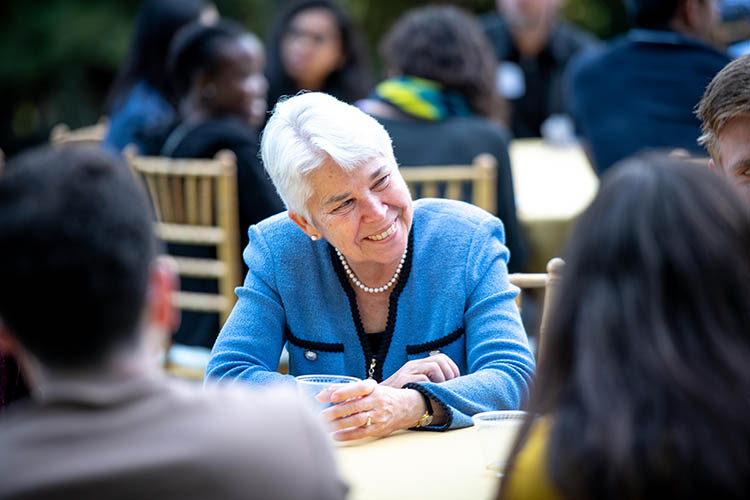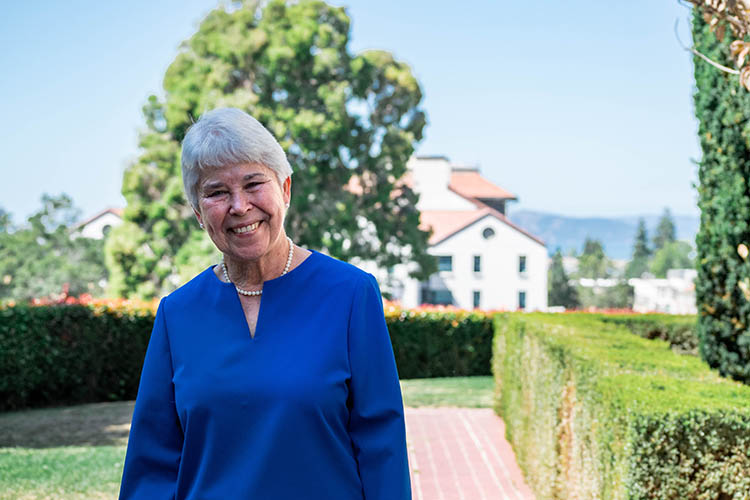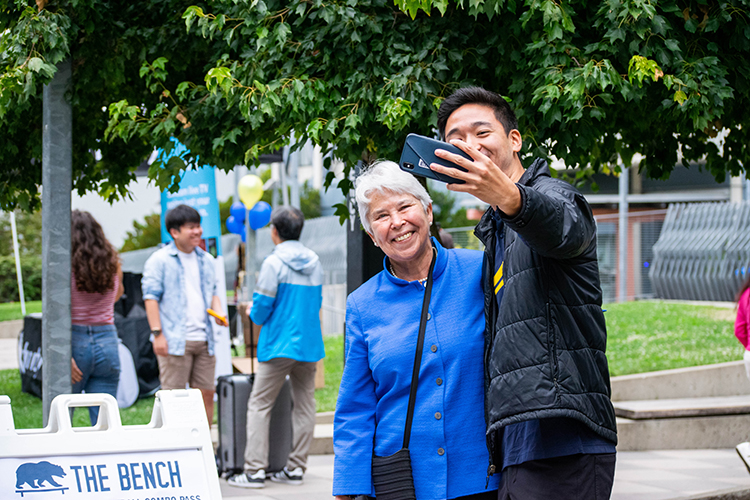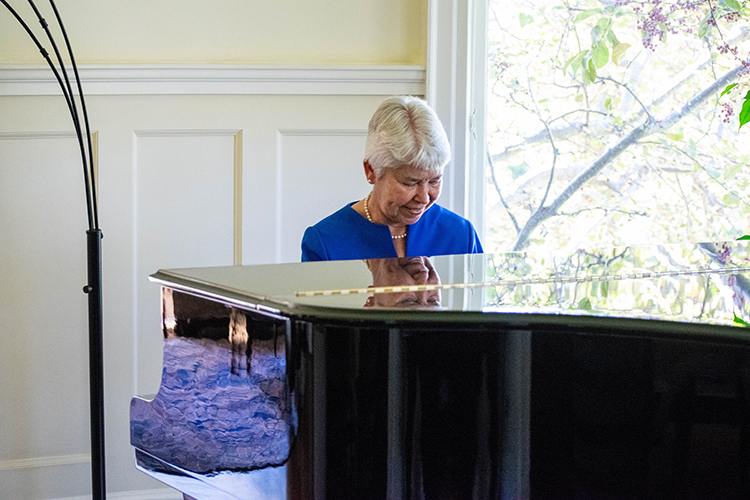A balanced budget, but chancellor’s fall backpack is heavy
In a wide-ranging interview, Carol Christ explains her plans for diversity, housing and seismic repairs — and talks about what keeps her grounded
September 10, 2019

The chancellor says talking with students is a favorite part of her busy schedule. (UC Berkeley photo by Keegan Houser)
Fall semester has set sail at UC Berkeley with a balanced budget, new hires to improve campus diversity and a start on growing the faculty. The waters aren’t calm, though. Buildings need seismic repair, low numbers of underrepresented minority students persist, and there’s insufficient student housing. But it’s full speed ahead for Carol Christ, in her third school year at Berkeley as chancellor. Energetic, optimistic, determined and a role model for wellness, she recently talked with Berkeley News about how she’ll navigate the new school year.
In August, you shared publicly that a seismic assessment of some 600 campus buildings rated 62 as “poor” and six as “very poor.” More than $1 billion already has been spent on seismic improvements at Berkeley; it will take at least that much to finish. Where will the funding come from? And should anyone fear these buildings?
I don’t see how we can meet this seismic challenge without help from the state. Every project is going to need multiple funding sources, including philanthropy, long-term debt financing, deferred maintenance funds and university contributions. And it’s critical for the whole UC system to have a bond measure on a statewide ballot. There hasn’t been one since 2006, so we’re working on this with the legislature and the governor’s office. It could be voted on as early as March; any bond measure would need to be passed by the California legislature and then approved by the governor before going to voters.
The university has, for decades, had a robust seismic reinforcement program. As a public institution, we are held to a very high standard of safety, and that’s entirely right. As we experience more earthquakes worldwide and seismic technology improves, we’re getting better at understanding risks and are working to remediate as effectively as we can.
Each of the six “very poor” buildings has problems of very different dimensions. Evans Hall and Moffitt Library, for example, have reinforced concrete that was common in construction in the 1960s, but turned out not to be very resilient in an earthquake. In the ‘90s, after the Loma Prieta quake, we retrofitted Moffitt. Now, with our updated safety standards, we have to do it again.
Certainly, if we had any sevens (the worst rating —“dangerous” —on the seven-level scale for performance in a quake), we’d take those structures out of circulation. We’ve done that with other old buildings.
No doubt, this school year we’re dealing with a giant chess game or Rubik’s cube. We can’t address everything all at one, so we have to figure out what buildings to retrofit or demolish, and where to decant people who work in those buildings, and the programs in them. Obviously, Evans, which is a six, is in use every day and is high on our list of priorities. This is our project for the year: figuring out this sequence of emptying, relocating, reinforcing.
To be clear, the UC wasn’t required to rate its buildings’ expected seismic performance in a large-scale earthquake, so we are ahead of the curve with this assessment. There are few, if any, parallel efforts in the private sector. We imposed this code on ourselves to get in front of the next Loma Prieta, and we have much more work to do. We can spare no effort to make sure the campus is as safe as possible.
Comprehensive efforts also are underway at Berkeley to address our low numbers of underrepresented minorities and to improve the campus climate for these groups. The percentage of undergraduate African American and Native American students, for example, has been in the single digits for decades. Are there signs the situation is turning around?
It’s going to take much more investment in recruitment and yield activities. We’re the UC campus that’s made least progress on diversity; we have the lowest proportion of underrepresented students. We used to be the most diverse campus in the system, and now we’re the least diverse. What happened was Prop. 209. We bent over backward to meet the requirements, but I think we now understand what we can do without violating 209 to increase our applications and yield. There are no restrictions on outreach and yield.
We need to have more robust relationships with feeder high schools that have diverse populations, bring more underrepresented students to campus for summer programs, and try to pursue the students we admit. The new director of admissions, Femi Ogundele, is fabulous, and he’s brought passion and determination and new energy and a lot of new ideas to campus.
For too long, the story has been that Berkeley really cares about diversity, but that we’re not Southern California, which is a more diverse area, or that we’re laboring under Prop. 209. Those are excuses. I believe we can change it. For example, we currently are interviewing candidates for a new job in admissions — an assistant director who will focus on recruitment of students from Native American populations.

Chancellor Christ asked for paintings from the recent “About Things Loved: Blackness and Belonging” exhibit at the Berkeley Art Museum to be installed at University House to showcase further on campus the talents of underrepresented minority artists. The six paintings there are by black artists Faith Ringgold, Margo Humphrey, Lyle Ashton Harris, Charles White and Julie Mehretu. (UC Berkeley photo by Irene Yi)
Oscar Dubón, our vice chancellor for equity and inclusion, is chairing a task force this semester about our efforts to become a Hispanic-Serving Institution in the next decade. As an HSI, a minimum of 25 percent of our full-time undergraduates must be Hispanic, and the federal designation can bring additional grant funding. Two-thirds of the babies born this year in California were Hispanic, and we need to be more representative of the population.
In my work with various undergraduate diversity working groups, I’ve been inspired to find ways to have their history more visible on campus, including their art. I saw a wonderful show at the Berkeley Art Museum this summer, and when it closed, I asked to have some of the works of art moved to University House. There are six works in University House from that exhibit, and several more from the museum that were created by women artists and artists of color. I’d like to see more art in public spaces that is representative of our diverse population.
Our African American Initiative Scholarship is now in its second year, and we’re developing a program for underrepresented students in STEM that is modeled on the very effective Meyerhoff Scholars Program at the University of Maryland, Baltimore County.
What work is underway to diversify the faculty this fall?
In consultation with other campus leaders, I have decided to create five clusters of new faculty members who are experts on topics related to populations that have been historically underrepresented in scholarship at American universities. The first cluster of up to six new faculty hires, spread across departments, will be experts on issues about Native Americans and indigenous peoples in the United States. Funding for two of those positions has been allocated for searches this academic year — one in Native American and indigenous law and the other in Native American studies and the environment. In future years, searches will take place for scholars in Native American studies, Native American/public history, Native American health and Native American performing and visual arts.
The topics of the other four clusters are yet to be determined. Among the possibilities are six —climate and environmental justice, criminal justice and social inclusion, the Latinx community and democracy, artificial intelligence and the new dynamics of inequality in the United States, understanding non-citizenship and issues concerning people with disabilities.
In general, we definitely are beginning to increase the size of the faculty. We have a larger cohort that joined this year, and we’ve commissioned a larger number of searches.

The chancellor, who arrived on campus in 1970 as an assistant professor of English, is beginning to increase faculty hiring this school year, strategically placing new hires in areas where there is great enrollment pressure and in relationship to the campus’s diversity goals. (UC Berkeley Photo by Irene Yi)
The budget is balanced this school year, through a combination of budget cuts and revenue increases, after the steepest budget deficit in Berkeley’s history, $150 million, in 2016. What does this mean for the campus?
One of the things people would like to imagine is that there now is lots of money floating around, and everything is Easy Street. But that’s not the case. We have a balanced budget, but, according to Rosemary Rae, our chief financial officer, it’s precariously balanced. We really had to cut to the bone to balance it, so we can’t say, “There’s a banquet. Come in and feast.”
In terms of the faculty, we hope to grow it by 100 positions in the next five years, but even that won’t be enough. To get to the right student/faculty ratio, we’d have to add 350 more faculty. We’ve grown the student body by 9,000 and not increased the faculty. Now, we have money, so we’re trying to be strategic about faculty positions, putting them in areas where there is a great deal of enrollment pressure, and shaping the hiring in relation to our diversity goals.
You are dedicated to building more student housing on campus, doubling the number of beds by 2028. Why is this so important to you?
In college, you learn as much from your fellow students as you do in all your classes. If you’re not with them, and you have roommates far away, students tell me it limits the breadth and depth of their relationships.
But it’s hard and expensive to find housing in Berkeley. Too many students live in housing that’s too crowded and too expensive and forces them to compromise other needs. We’ve become a commuting school, as students live further from campus. With each BART train that comes into the station, there are incredible numbers of students getting off the train.

A student takes a selfie with Chancellor Christ on Move-in Day 2019. (UC Berkeley photo by Irene Yi)
University housing is one of our biggest challenges. We have 9,653 beds this fall, and 31,500 undergraduates. And being in city of Berkeley, there always are a lot of controversies over land use. But we need to build on every piece of land we have in order to double our stock
Our Housing Master Plan calls for providing two years of university housing for entering freshmen undergraduates, one year for entering transfer undergraduates and one year for incoming graduate students. We also plan to maintain the number of university housing units suitable for students with children and provide up to three years of university housing for new, untenured ladder faculty.
There are many community benefits to the housing we plan to build. In People’s Park, for example, we will be creating both student housing and supportive housing for the homeless. You can’t live in the Bay Area and not be saddened by the homeless crisis, and I think the university should partner with the city and play a part in beginning to solve it. The solution to homelessness is housing.

Chancellor Christ, who plays the piano and the viola, makes time for music by practicing each day, taking lessons and participating in a string quartet. (UC Berkeley photo by Irene Yi)
As chancellor, you’ve got a high-stress job. What do you do to unwind, and what can you tell students about the importance of prioritizing wellness?
I walk every day for half an hour at 6 a.m., and as many days as possible a week, I practice viola in the morning. I also take viola lessons and am part of a quartet. I started playing viola in my 40s, but I’ve played the piano from the time I was a kid. I make time to see my friends and family. And I like to go to arts events.
When I talk to students, I always say, “You should sleep, you should eat well, you should take time to be with family and friends, you should take time to do the things you love. You should exercise. The key to happiness is a well-balanced life. If you don’t start doing it here at Berkeley, you won’t do it later on.” I see too many anxious students unproductively stressing about things. This is the freest time in so many young men’s and women’s lives, so they need to take time to explore and to set healthy habits for their future.